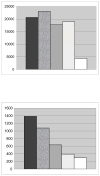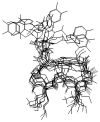Structural and Biophysical Characterization of a Cyclic Bioadhesive With Cell Attachment Ability
- PMID: 26052158
- PMCID: PMC4454480
- DOI: 10.1080/00218460903418154
Structural and Biophysical Characterization of a Cyclic Bioadhesive With Cell Attachment Ability
Abstract
Structural and cellular attachment analysis identified overall bent helical regions of adhesive peptides identified within mussel adhesive protein (MAP) capable of also attaching cells. DOPA (L-DOPA, 3,4-dihydroxyphenylalanine) is frequently identified and credited for the attachment ability of several marine proteins [Olivieri, MP, et al. (2002), Biofouling18, 149-159]. Newly designed cyclic peptides (DOPA-G-G-C-G-K-A-K-G-C [cyc-DOPA] & Y-G-G-C-G-K-A-K-G-C [cyc-Y]) derived from structurally conserved regions of several MAP peptides were examined to assist in the understanding of both surface and cellular attachment. Solution-state proton nuclear magnetic resonance (NMR) spectroscopy coupled with molecular modeling and dynamics revealed minimal differences in the structures of the proposed cellular attachment domain within these two peptides. Multiple attenuated internal reflection infrared (MAIR-IR) spectroscopy, ellipsometry and advancing contact angle analyses showed that formation of thin films by these peptides was L-DOPA and pH dependent. When compared to control surfaces, undifferentiated leukocyte cells (MOLT-4) significantly attached and spread onto films created from the cyc-DOPA. The culmination of these structural, biophysical and cellular attachment techniques reveal a conformation of cyc-DOPA that is capable of both adsorbing to surfaces and then attaching cells that spread. This work supports the sequence, K-A-K, as the cellular attachment domain, especially when held in a reliable structural conformation.,.
Keywords: NMR; cell attachment; peptide structure; protein adsorption; surface chemistry.
Figures








Similar articles
-
Depressing time: Waiting, melancholia, and the psychoanalytic practice of care.In: Kirtsoglou E, Simpson B, editors. The Time of Anthropology: Studies of Contemporary Chronopolitics. Abingdon: Routledge; 2020. Chapter 5. In: Kirtsoglou E, Simpson B, editors. The Time of Anthropology: Studies of Contemporary Chronopolitics. Abingdon: Routledge; 2020. Chapter 5. PMID: 36137063 Free Books & Documents. Review.
-
Comparison of Two Modern Survival Prediction Tools, SORG-MLA and METSSS, in Patients With Symptomatic Long-bone Metastases Who Underwent Local Treatment With Surgery Followed by Radiotherapy and With Radiotherapy Alone.Clin Orthop Relat Res. 2024 Dec 1;482(12):2193-2208. doi: 10.1097/CORR.0000000000003185. Epub 2024 Jul 23. Clin Orthop Relat Res. 2024. PMID: 39051924
-
A Blog-Based Study of Autistic Adults' Experiences of Aloneness and Connection and the Interplay with Well-Being: Corpus-Based and Thematic Analyses.Autism Adulthood. 2023 Dec 1;5(4):437-449. doi: 10.1089/aut.2022.0073. Epub 2023 Dec 12. Autism Adulthood. 2023. PMID: 38116056 Free PMC article.
-
The effectiveness of school-based family asthma educational programs on the quality of life and number of asthma exacerbations of children aged five to 18 years diagnosed with asthma: a systematic review protocol.JBI Database System Rev Implement Rep. 2015 Oct;13(10):69-81. doi: 10.11124/jbisrir-2015-2335. JBI Database System Rev Implement Rep. 2015. PMID: 26571284
-
Impact of residual disease as a prognostic factor for survival in women with advanced epithelial ovarian cancer after primary surgery.Cochrane Database Syst Rev. 2022 Sep 26;9(9):CD015048. doi: 10.1002/14651858.CD015048.pub2. Cochrane Database Syst Rev. 2022. PMID: 36161421 Free PMC article. Review.
References
-
- Waite JH, Housley TJ, Tanzer ML. Biochem. 1985;24:5010–5014. - PubMed
-
- Waite JH. Int J Adhesion and Adhesives. 1987;7:9–14.
-
- Olivieri MP, Wollman RM, Hurley MI, Swartz MF. Biofouling. 2002;18:149–159.
-
- Olivieri MP, Baier RE, Loomis RE. Quenching of surface polarity as a mechanism to reduce cell adhesion. Transactions of the Society For Biomaterials. 1990;XIII:78.
-
- Olivieri MP, Loomis RE, Meyer AE, Baier RE. J Adhesion Science and Technology. 1990;4:197–204.
Grants and funding
LinkOut - more resources
Full Text Sources
Other Literature Sources
